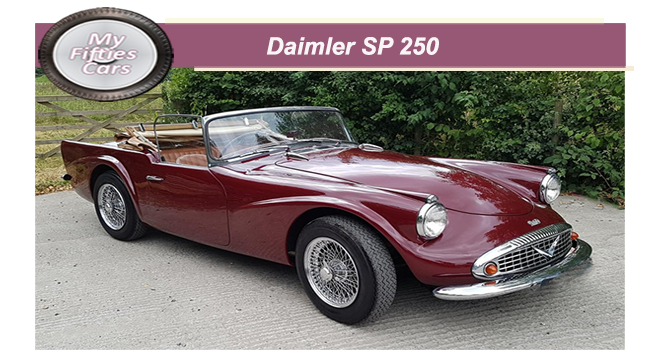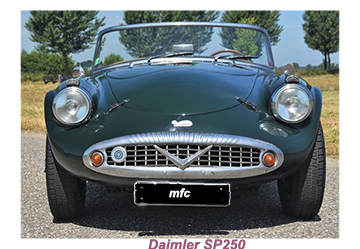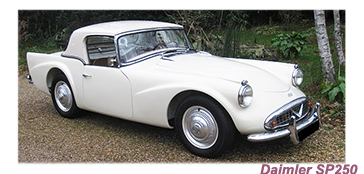
Initially launched in 1959 at the New York Motor Show as the Dart, Daimler's first sports car was officially renamed the SP250 after Dodge claimed copyright on the original title.
T he SP250 was a barefaced attempt to ride the wave of popularity for British sports cars in America, and it looked much more transatlantic than the Triumph or MG competitors on which its chassis was based. Daimler's boldness, and hurry to enter the market, resulted in confused styling.
he SP250 was a barefaced attempt to ride the wave of popularity for British sports cars in America, and it looked much more transatlantic than the Triumph or MG competitors on which its chassis was based. Daimler's boldness, and hurry to enter the market, resulted in confused styling.
From the front, the SP 250'S fibreglass moulded lines seemingly sliding down to the wide grille. From the rear three-quarter view, the futuristic horizontal and vertical lines forming the car's outrageous fins that seem to belong to another vehicle.
Once the initial problems that Daimler experienced with the 250's chassis had been ironed out, the car began to become something of an icon, thanks to its good looks, coupled to its responsive acceleration.
 It was the latter attribute that earned the Daimler SP250 its most loyal followers, the British police, who invested in a number of automatic versions as high-speed pursuit vehicles.
It was the latter attribute that earned the Daimler SP250 its most loyal followers, the British police, who invested in a number of automatic versions as high-speed pursuit vehicles.
For Daimler, the SP250 was really a fairly dramatic departure from their usual design strategy,
![]()

 Thanks to the combination of being a great sports car and from such an unexpected source, the Daimler 250 earned its place in Fifties motoring history - a product of the very specific and growingly optimistic social climate that was bubbling just below the surface as the Sixties were drawing to a close.
Thanks to the combination of being a great sports car and from such an unexpected source, the Daimler 250 earned its place in Fifties motoring history - a product of the very specific and growingly optimistic social climate that was bubbling just below the surface as the Sixties were drawing to a close.
Despite the false optimism bounding through the corridors at Daimler, after the departure of the Dockers, the fate of the SP250 was sealed as early as 1960 when Jaguar took over the ailing Daimler concern.
Jaguar had no real attention of adding new models, instead they were only interested in boosting their production capacity.
 Sir William Lyon's reportedly only felt disdain for the Dart, especially its design.
Sir William Lyon's reportedly only felt disdain for the Dart, especially its design.
In the face of Lyon's objections, the company persevered with the SP250 well into the Sixties amid concerns were that the SP250 would become a poor man's version for the E-ype.
With acceleration capability of 0-60 mph in 9.5 seconds, there might have been some depth in their apprehension.
![]()
Jaguar showed their usual shrewdness, fitting the Dart SP250's excellent engine in the Daimler version of their Mkll called the 2.5-litre V-eight.
 For Daimler, the SP250 was really a fairly dramatic departure from their normal design strategy.
For Daimler, the SP250 was really a fairly dramatic departure from their normal design strategy.
 Thanks to the combination of being a great sports car and from such an unexpected source, once the initial problems that Daimler experienced with the 250's chassis had been ironed out, the car became something of an icon, thanks to its good looks, coupled to its responsive acceleration.
Thanks to the combination of being a great sports car and from such an unexpected source, once the initial problems that Daimler experienced with the 250's chassis had been ironed out, the car became something of an icon, thanks to its good looks, coupled to its responsive acceleration.
It was the latter attribute that gained the Daimler SP250 its most loyal followers, the British police, who invested in a number of automatic versions for use as high-speed pursuit vehicles.
Today the many flaws of the unhappy Daimler SP250 are seen as endearing and characterful, and survivors are highly prized.


